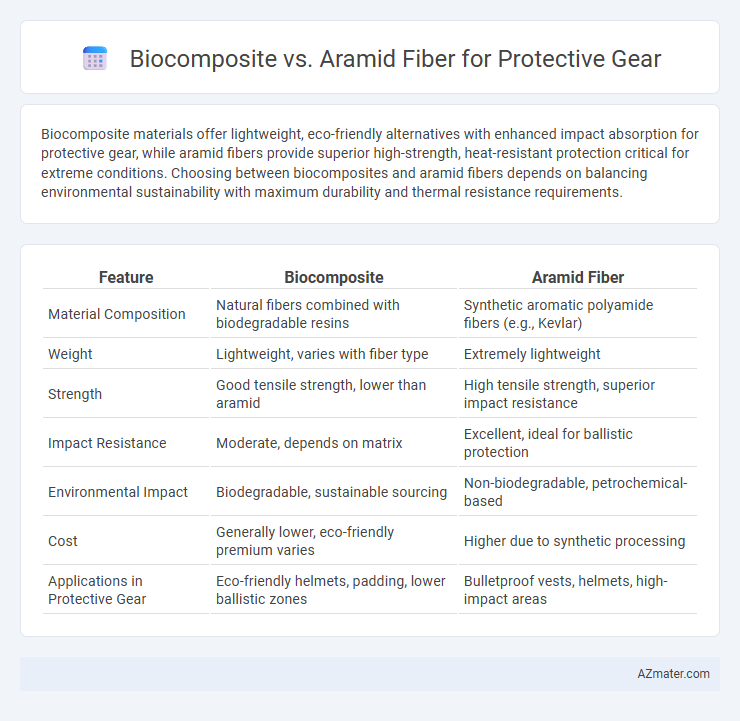Biocomposite materials offer lightweight, eco-friendly alternatives with enhanced impact absorption for protective gear, while aramid fibers provide superior high-strength, heat-resistant protection critical for extreme conditions. Choosing between biocomposites and aramid fibers depends on balancing environmental sustainability with maximum durability and thermal resistance requirements.
Table of Comparison
| Feature | Biocomposite | Aramid Fiber |
|---|---|---|
| Material Composition | Natural fibers combined with biodegradable resins | Synthetic aromatic polyamide fibers (e.g., Kevlar) |
| Weight | Lightweight, varies with fiber type | Extremely lightweight |
| Strength | Good tensile strength, lower than aramid | High tensile strength, superior impact resistance |
| Impact Resistance | Moderate, depends on matrix | Excellent, ideal for ballistic protection |
| Environmental Impact | Biodegradable, sustainable sourcing | Non-biodegradable, petrochemical-based |
| Cost | Generally lower, eco-friendly premium varies | Higher due to synthetic processing |
| Applications in Protective Gear | Eco-friendly helmets, padding, lower ballistic zones | Bulletproof vests, helmets, high-impact areas |
Introduction to Protective Gear Materials
Protective gear materials must balance strength, durability, and impact resistance to ensure user safety in high-risk environments. Biocomposites offer sustainable, lightweight alternatives with good mechanical properties derived from natural fibers combined with polymer matrices, providing eco-friendly solutions. Aramid fibers, such as Kevlar, are renowned for superior tensile strength and heat resistance, making them a preferred choice in ballistic and cut-resistant applications.
What Are Biocomposites?
Biocomposites are sustainable materials made by combining natural fibers such as hemp, flax, or jute with a polymer matrix, offering enhanced biodegradability and lower environmental impact compared to synthetic fibers. In protective gear, biocomposites provide lightweight strength and flexibility, suitable for applications demanding moderate impact resistance and eco-friendly alternatives. Unlike aramid fibers, known for superior tensile strength and heat resistance used in ballistic and fire-resistant gear, biocomposites balance performance with sustainability but typically exhibit lower mechanical properties.
Understanding Aramid Fibers
Aramid fibers, known for their exceptional strength-to-weight ratio and thermal stability, are widely used in protective gear such as bulletproof vests and helmets. These synthetic fibers exhibit high tensile strength and excellent resistance to abrasion and heat, making them ideal for impact and ballistic protection. Compared to biocomposites, aramid fibers provide superior durability and consistent performance in extreme conditions, though they lack the eco-friendly benefits and biodegradability associated with biocomposite materials.
Mechanical Performance Comparison
Biocomposite materials exhibit lower tensile strength and impact resistance compared to aramid fibers, which provide superior energy absorption and high durability in protective gear. Aramid fibers demonstrate excellent resistance to abrasion and cutting, making them ideal for applications requiring enhanced mechanical performance under extreme conditions. The stiffness-to-weight ratio of aramid fibers significantly surpasses that of biocomposites, resulting in lighter yet stronger protective equipment.
Weight and Flexibility Differences
Biocomposite materials used in protective gear are notably lighter than aramid fibers, offering enhanced comfort and reduced fatigue during prolonged use. Flexibility in biocomposites generally surpasses that of aramid fibers, enabling better conformability to body movements without sacrificing protection. Aramid fibers, while heavier, provide superior tensile strength and abrasion resistance, making them ideal for high-impact scenarios where durability is critical.
Environmental Impact and Sustainability
Biocomposite materials in protective gear offer significant environmental benefits by utilizing renewable resources and enabling biodegradability, reducing carbon footprint and waste accumulation compared to aramid fibers. Aramid fibers, while highly durable and effective in impact resistance, rely on petroleum-based processes that contribute to higher greenhouse gas emissions and are challenging to recycle. Emphasizing sustainability, biocomposites promote circular economy principles through plant-based constituents and lower energy consumption during manufacturing, making them a greener alternative for eco-conscious protective equipment.
Cost Analysis: Biocomposite vs Aramid
Biocomposite materials for protective gear typically offer a lower cost advantage compared to aramid fibers, primarily due to the abundance and renewability of natural fibers like flax or hemp. Aramid fibers, such as Kevlar, involve higher manufacturing expenses driven by complex chemical synthesis and processing techniques. Overall, biocomposites present a cost-efficient alternative for protective equipment without compromising basic performance, whereas aramid fibers dominate in applications demanding superior strength and heat resistance despite their premium price.
Comfort and Wearability Factors
Biocomposite materials in protective gear offer enhanced breathability and reduced weight, significantly improving comfort during extended wear compared to aramid fibers, which tend to be heavier and less flexible. Aramid fibers provide superior impact resistance and durability but often compromise wearability due to stiffness and limited moisture wicking properties. Balancing protection and comfort, biocomposites excel in ergonomic design and thermal regulation, while aramid fibers remain preferred for high-impact environments requiring maximum abrasion resistance.
Real-World Applications in Protective Gear
Biocomposite materials in protective gear offer sustainable alternatives with excellent impact absorption and lightweight properties, making them suitable for helmets and body armor in sports and military sectors. Aramid fibers, such as Kevlar, provide superior tensile strength and thermal resistance, widely used in ballistic vests and firefighting apparel for enhanced protection against high-velocity projectiles and extreme heat. The choice between biocomposite and aramid fiber depends on specific application requirements, balancing environmental impact, durability, and performance standards in real-world protective equipment.
Future Trends in Protective Material Development
Biocomposite materials are gaining momentum in protective gear development due to their sustainability, lightweight properties, and biodegradability, offering an eco-friendly alternative to traditional fibers. Aramid fibers, renowned for their exceptional strength, heat resistance, and durability, continue to dominate high-performance applications but are increasingly complemented by hybrid composites integrating biobased matrices. Future trends emphasize the synergy between aramid fiber's protective excellence and biocomposite innovations to create advanced, cost-effective, and environmentally responsible protective solutions tailored for military, industrial, and sports sectors.

Infographic: Biocomposite vs Aramid fiber for Protective gear
 azmater.com
azmater.com